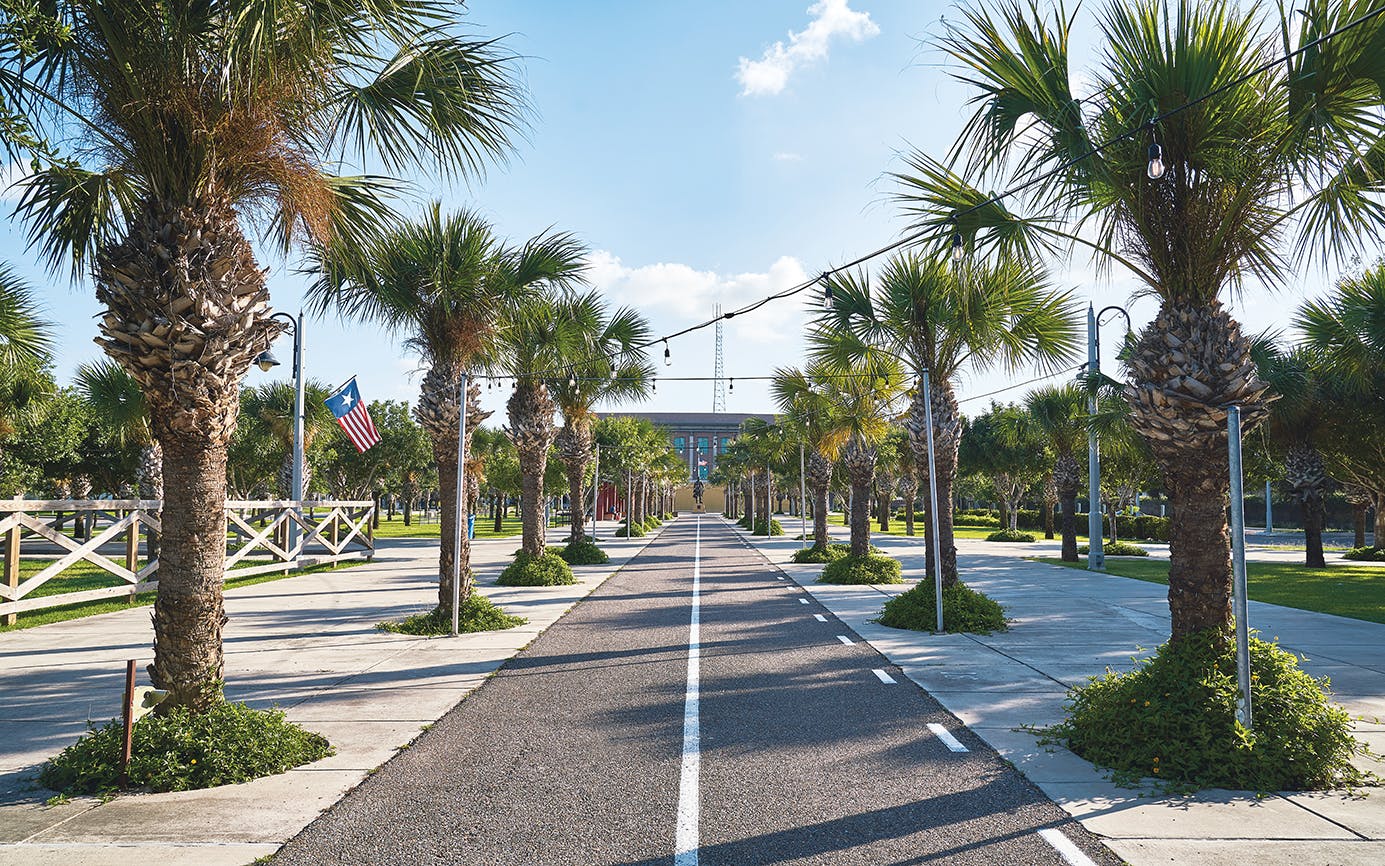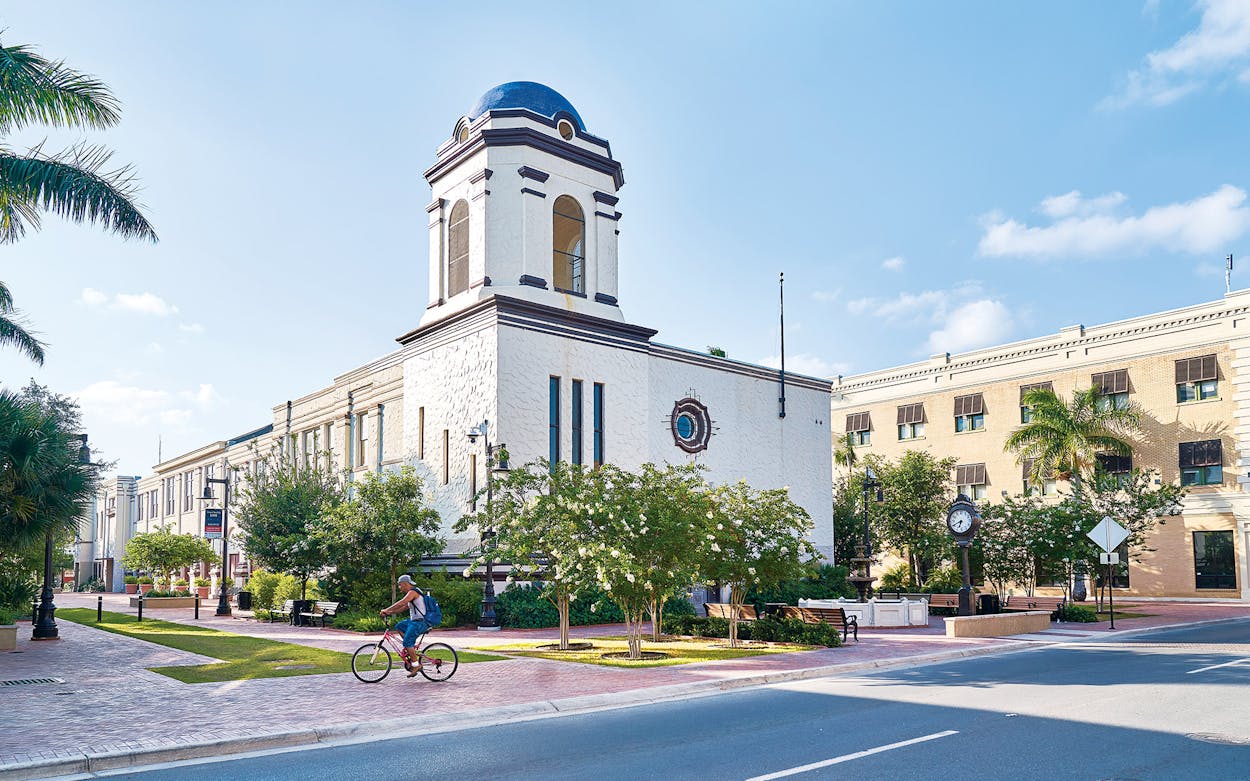The farther afield you venture from our urban bastions, the more likely you are to encounter folks who feel that their patch of the Lone Star State is unappreciated, misunderstood, or ignored. You hear it on the High Plains and deep in the Piney Woods. But perhaps nowhere is that sentiment more palpable than way down at the southern tip, in Brownsville.
First, consider the persistent myth that border towns are unusually dangerous. In fact, according to annual crime reports compiled by the FBI, Brownsville is one of the safest cities in Texas. Then there’s the perception that Brownsville is hot. Well, this is accurate. But summer’s temperatures rarely climb more than a notch or two above the highs seen in Austin or Houston, and the steady breeze that blows in from the Gulf of Mexico ensures that warm days are at the very least tolerable and often pleasant. And, from November to March, as winter storms pelt the Dallas–Fort Worth Metroplex, the Rio Grande Valley teems with snowbirds fishing, golfing, cycling, and otherwise frolicking in temperatures that can hover in the balmy seventies.
Brownsville’s proximity to the sandy beaches of South Padre Island, an easy thirty miles east of town, and the area’s many historic landmarks—battlefield buffs, take note—are enough reason to visit. But there’s a lot more to this city of about 183,000 people. Passionate locals are working to bring a dormant downtown back to life, and a new network of hike-and-bike trails is making the local natural attractions more accessible to cyclists and nature lovers.
In four years, Brownsville will celebrate its 175th birthday—its dodransbicentennial, if you will. Juan Vélez, the city’s historic preservation officer, walks with me through downtown, recalling the architects who brought French Quarter flair to the Rio Grande when they arrived to the area by steamship from New Orleans in the 1830s to help build the town of Matamoros, Mexico. Then they crossed the river north as the newer settlement of Brownsville rose to prominence. “They simply came here and applied the same designs,” says Vélez as he points out the architectural flourishes of buildings constructed from the later 1800s through the booming 1920s. But as Brownsville sprawled outward in the second half of the twentieth century, the city’s downtown faded, its historic structures more or less conserved by decades of benign neglect. Vélez is on a mission to protect his hometown’s architectural treasures.
In the past year or so, the vintage character of Brownsville’s long-overlooked downtown has begun to lure homegrown entrepreneurs back to the city center, as have the low rents and generous municipal grants for repairs. On a Wednesday afternoon, I watched Christopher Galicia plug in his sous vide machines to infuse small batches of liquor with rose petals and other botanicals for the evening’s drinks at the stylish Las Ramblas Cocktail Lounge. “I remember coming downtown when I was a kid with my grandma to the little tiendas,” Galicia says. Otherwise, he adds, “I never came downtown, ever. There was no reason to.”

Las Ramblas opened this May on Market Square, the newly renovated hub of Brownsville’s nascent arts and entertainment district, where half a dozen bars and a mix of upscale and casual restaurants surround the square’s handsome open spaces and main hall. The magnificent stucco-covered Spanish Colonial Revival building, originally built in 1850, was a thriving open-air market for nearly a century, until the last vendors packed up their produce in 1948. The city eventually repurposed the space for its bus terminal. Then came a nearly decade-long project to renovate the hall and replace two blocks of city streets with parklike pedestrian areas, culminating two years ago with the restoration of the square’s iconic blue-domed bell tower, the area’s most striking architectural landmark.
Music fills the air as shoppers from Mexico search for bargains just blocks from the trendsetting spots and old standbys around Market Square. One of those classic places is Rutledge Hamburgers, a nearly century-old burger stand that occupies a gap between buildings that is so narrow that patrons often pose for photos with their arms spread and hands resting on either wall. Two miles east is Vera’s Backyard Bar-B-Que, opened in 1955, the only commercial operation in Texas that still prepares silky-smoky barbacoa de cabeza in a traditional underground pit. Things are changing fast in the city center, but old and new Brownsville can coexist, insists Miriam Suarez, the city’s downtown district manager. “They both speak to our shared border culture,” she says.

DISTINCTIVE DESIGN
Brownsville’s most distinctive architectural style is Border Brick, a marriage of New Orleans flourishes (balconies and French double doors) and Mexican architecture (boxlike buildings and interior courtyards), all held together with bricks of Rio Grande mud.
El Hueso de Fraile is proof. In 2012, not long after renovations to Market Square began, Adrian and Laura Foncerrada and their musical family ignited the downtown entertainment scene when they opened this coffee shop and live-music venue. Musicians take the stage at El Hueso every night at 8:30, and the Foncerrada family ensemble performs here on weekends. One of the Foncerradas’ sons, Luis, is a founder of the South Texas Music Incubator, a nonprofit that nurtures local artists and is a driving force behind First Friday, Market Square’s monthly live-music and artisan showcase.
One of First Friday’s participating venues, an upscale eatery facing Market Square called Dodici Pizza & Wine, is co-owned by Brownsville mayor Juan “Trey” Mendez and operates in a Border Brick building (see “Distinctive Design,” page 26) constructed by a Spanish-born mercantile owner in 1883. The restaurant’s lush interior courtyard is shaded by a pair of glossy-leaved fruit trees. The pizzas are thin yet delectably chewy, with toppings ranging from Gulf shrimp paired with yellow squash and clouds of ricotta to dry chorizo and local honey infused with smoked chile pequin. Although the clientele mostly hails from the Brownsville area and Mexico, Dodici co-owner Dante Pensa has noticed that some beachgoers are finding their way down from South Padre. “By Tuesday or Wednesday on spring break, we start seeing a lot of people with neon clothes and sunburns,” he tells me.
Locals often get their sunburns at South Padre’s less-traveled neighbor, Boca Chica Beach, at the mouth of the Rio Grande. Or they head to the slender green waterways called resacas in and around town, ancient tributaries of the Rio Grande. These shallow pools, teeming with birdlife and vegetation, help beautify and cool off the vast river delta that we call a valley.
Wanting to connect several of its most serene resacas with parks and other attractions in the area, Brownsville and other neighboring towns have spent the past several years constructing the vast Caracara Trails network: 230 miles of paved hike-and-bike trails, another 120 miles of roadside bicycle routes, and a long paddling trail that invite a more active approach to sightseeing. (Tip: I like to fuel up for my ride at the trailside coffee-and-cycle shop 7th & Park, within spitting distance of the museums and the Gladys Porter Zoo, in Brownsville’s Mitte Cultural District, just north of downtown.) With practically no hills to pedal up, and with many parts shaded by palm trees, the trails allow cyclists to comfortably cruise from such sites as the first battlefields of the Mexican-American War over to South Padre Island and up through Laguna Atascosa National Wildlife Refuge, a 97,000-acre sanctuary for green jays and caracaras as well as the ocelot, an endangered cat that hides in the region’s ubiquitous thornscrub.

The coastal plains of the lower Rio Grande Valley witnessed both the opening salvo of the Mexican-American War and the death rattle of the Civil War. Military enthusiasts can wander the cactus-studded fields where major battles were fought and then head over to the impressively ornate brick buildings of Fort Brown, initially founded as Fort Texas by future U.S. president Zachary Taylor in 1846. Part of the fort sits on the campus of Texas Southmost College and part on a defunct golf course, where, if you look closely, you can still see a cannon sticking out of the ground marking the spot where Major Jacob Brown, the namesake of both fort and town, died under bombardment by Mexican cavalry.
After all that cycling and exploring, the shore beckons. On a recent evening with daylight to spare, the ocean just half an hour away, I grabbed a pizza to go from Dodici and drove toward Boca Chica. The road to the coast passed Palmito Ranch, where the final land battle of the Civil War was waged, and, a few miles later, the launch site for SpaceX, the spacecraft manufacturer owned by eccentric tech entrepreneur Elon Musk. One of the company’s futuristic test vehicles, the shiny metal Starhopper, sits beyond a chain-link fence as if ready for blastoff.
The pavement ended in sand. Families were fishing and swimming on the Mexican side of the Rio Grande, but the beaches on the American shore were quieter. An hour later the sun fell beyond the dunes, swept there by a coastal breeze on its way inland to Brownsville.
This article originally appeared in the October 2019 issue of Texas Monthly with the headline “Bordering on Greatness.” Subscribe today.
- More About:
- Brownsville









